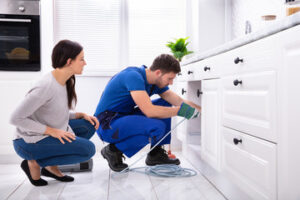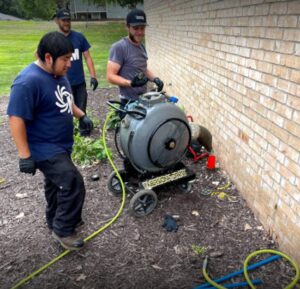Clogged drains are more than a nuisance—they can spread germs, and foul odors and block water flow. A regular cleaning schedule for your kitchen and bathroom drains will keep them functioning correctly. Contact Philadelphia Drain Cleaning for professional assistance.
You can also try some DIY methods to clean your drains. But remember, chemical drain cleaners are corrosive and can damage your pipes.
Clogged drains are one of the most common and annoying plumbing mishaps homeowners encounter. They can affect almost every household drain, from the kitchen sink to the bathtub. They often happen at the most inconvenient times and can result in costly after-hours call-out fees. With a little know-how, however, you can keep your drains clear of obstructions without reaching for toxic chemical cleaners.
The most common cause of a clogged sink or tub is soap residue, which builds up and becomes a tangled mess over time. Other culprits include hair, cigarette butts, food scraps and other organic matter. Even small amounts of these items can result in slow drainage or complete blockage. Luckily, a few household items can help you disintegrate and wash away most drain clogs.
First, try flushing the drain with hot water. If this does not work, it is probably time to try a plunger or a wire drain snake. If the problem persists, you may need to remove the pop-up assembly and feed the wire snake into the drain while cranking it. The snake will entangle with the clog and break it up, pushing it down through the pipes.
If the plunger or snake does not work, you may need to call in a professional. This is especially true if the clog involves multiple drains or is located in the sewer line, which can cause flooding, a backup of waste and other issues throughout your home.
If you have a grease clog that just won’t budge, consider using an eco-friendly product like Bio-Clean to dissolve the fat. The natural enzymes in this nontoxic product will eat away at the blockage without damaging your pipes or the environment. You can purchase Bio-Clean at most hardware stores and it comes in a convenient pouch that you just place down the drain. It takes a while for this product to work, but it will eventually get the job done. Once your drains are free of obstructions, it’s a good idea to use it once or twice a week to avoid future problems.
Dirty Drains
Many people are familiar with the foul odors that can be associated with a dirty drain. This unpleasant odor is caused by the build-up of bacteria and other microorganisms that are released when water can’t flow through a blocked drain. These smelly odors can cause serious health issues, including asthma, so it is important to clean your drains regularly.
A clogged drain can also provide an ideal breeding ground for pests, including spiders, ants, and mosquitoes. These pests can carry diseases and parasites that are harmful to humans, including salmonella, E coli, and Campylobacter. In addition, clogged drains can cause water or sewage to back up into your home, which can pose a serious health risk.
Dirty drains can be cleaned with a variety of chemicals, but it is best to use natural cleaning substances when possible. Begin by pouring a half-gallon of boiling water down the drain to loosen any clogs. If this doesn’t work, try using a drain cleaner that contains a strong deodorizer. After the clog is gone, flush your drain with warm water by pouring down 2 to 3 cups of near-boiling water. Repeat this process if necessary.
It is also a good idea to keep pet litter out of your drains, as it can block pipes. If you have a cat, train it to use the litter box, instead of flushing it down the toilet. If you accidentally flush pet waste, call a plumber immediately for drain cleaning to avoid an expensive clog.
Regular drain cleaning can also reduce the amount of dirt and debris that ends up in our oceans. This dirt and debris can clog and damage our sea ecosystems, which is why it is important to clean your drains regularly.
To help keep your drains clean, you should try to use less oil, soap, and grease. You should also use hot water rather than cold water when cooking or washing dishes. Hot water helps to dissolve food scraps more effectively, while cold water will rinse them away. Lastly, be sure to use a strainer when putting food scraps into the garbage disposal. This will help to catch larger pieces and prevent them from getting caught in the drain line.
Clogged Toilets
Clogged toilets are a common household problem that can be frustrating and messy to deal with. Fortunately, most of the time these problems can be resolved with a bit of non-toxic DIY cleaning. Using a plunger to break up the blockage in the drain usually works, especially when plunging is combined with a few other cleaning solutions like dish soap and vinegar or caustic soda. For more serious clogs, the best solution may be to invest in an enzyme drain cleaner or sewer snake.
A common cause of a persistent toilet clog is improper items being flushed down the drain. It is important to remind children and adults what can and cannot be flushed in the toilet, including Q-tips, cotton balls, feminine products, paper towels, and more. Keeping these items out of the toilet can prevent frequent clogs and save on expensive plumbing repairs and replacements.
When a clog in the toilet drain becomes a serious issue, a sewer snake or auger might be needed to clear the obstruction. If you decide to try clearing the clog yourself, first shut off water supply to the toilet (turn the valve on the bottom left side of the toilet tank). Next, use a plunger to create a seal over the drain opening, and then push down and up forcefully while maintaining the seal. Repeat this process a few times to dislodge the clog.
If plunging doesn’t work, a mixture of hot water and soap can help lubricate the drain and dissolve any remaining debris. Add a half cup of liquid soap to the toilet and allow it to sit for 10 minutes, then flush. You can also fill a bucket with hot bath water (boiling water could crack porcelain toilets), and pour it into the toilet drain to help loosen and dislodge any lingering clogs.
If a clog is still present, you can buy or rent an enzyme drain cleaner from most grocery, hardware, and “big box” stores. These cleaners contain bacteria that break down and eat away at the waste material in your pipes, rather than the harsh chemicals found in many commercial chemical drain cleaners. However, this option can take a while to work, and it is important to read the instructions carefully before using it.
Clogged Sinks
There’s nothing quite like a clogged sink to put a damper on your everyday life. Whether you’re cooking dinner or taking a shower, it’s inconvenient and unsanitary to be left standing ankle-deep in water. So when your kitchen or bathroom drain starts to run slower than usual, it may be time for a little DIY drain cleaning. We talked to two plumbing experts—plumber Alan Soukup, owner of Bluefrog Plumbing and Drain of North Dallas, Texas, and Alicia Sokolowski, president and co-CEO of AspenClean, of Chicago, Illinois—to learn what the most common causes of clogged sinks are, as well as how to clear them on your own without the help of a plumber.
Food particles, grease, coffee grounds, hair and other debris can all end up stuck in your drains. They can also cause a complete blockage of the pipe, especially if they become lodged in your P- or J-trap (the curved pipe under your sink). To avoid these problems, be sure to keep small objects out of the drain and dispose of them properly.
If your clogged sink is caused by soap scum or grime, you can use hot water to clean the pipes and unclog your sink. However, be cautious: If your pipes are not rated for 212 degrees Fahrenheit, the boiling water could melt or deform the pipes and lead to leaks.
To try this method, first remove the stopper and any standing water from the drain. Then, fill the sink halfway with hot water, then slowly pour the rest down the drain, waiting a few seconds between each pour. Repeat as needed to dislodge the clog. If your clog is particularly stubborn, you can try using a plunger or wet/dry vacuum to loosen it. If you’re unable to break up the clog with either of these tools, you can try using a drain snake or auger, which are devices that run a metal cable through your pipe. Just be careful, as these can cause serious chemical and thermal burns if you don’t use them properly. Before you begin, ensure that the pipe is rated for the force of the tool and have eye protection and rubber gloves on hand.

